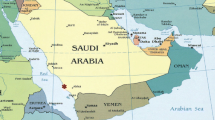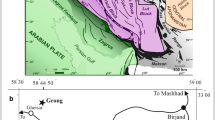Abstract
Decapod crustaceans are the most conspicuous predators and scavengers of modern chemosynthesis-based ecosystems at hydrothermal vents and hydrocarbon seeps; however, very little is known about decapod crustaceans at ancient seeps or vents. Some decapods, including galatheids, are known to produce highly specific, internally structured microcoprolites. Late Jurassic (Oxfordian) hydrocarbon-seep limestones from Beauvoisin (southeastern France) were found to contain such microcoprolites including Favreina fontana n. isp., F. cf. martellensis Brönnimann and Zaninetti, Palaxius salataensis Brönnimann, Cross and Zaninetti and Palaxius isp. These diverse ichnofossils indicate that crustaceans were also a part of ancient chemosynthesis-based ecosystems. This is the first report of crustacean coprolites from a deep-water environment.






Similar content being viewed by others
References
Baba K, Williams AB (1998) New Galatheoidea (Crustacea, Decapoda, Anomura) from hydrothermal systems in the West Pacific Ocean: Bismarck Archipelago and Okinawa Trough. Zoosystema 20:143–156
Barry JP, Greene HG, Orange DL, Baxter CH, Robison BH, Kochevar RE, Nybakken JW, Reed DL, McHugh CM (1996) Biologic and geologic characteristics of cold seeps in Monterey Bay, California. Deep-Sea Res I 43:1739–1762
Baudrimont AF, Dubois P (1977) Un bassin mésogéen du domaine péri-alpin: le Sud-Est de la France. Bull Centre Rech Explor Prod Elf Aquitaine 1:261–308
Becker MA, Chamberlain JA Jr (2006) Anomuran microcoprolites from the lowermost Navesink Formation (Maastrichtian), Monmouth County, New Jersey. Ichnos 13:1–9
Blau J, Grün B (1989) Palaxius montemeranoensis n. sp., ein Anomuren Koprolith aus roten Kalken der “Serie Toscana” (Lias, Italien). N Jb Geol Paläont Mh 1989(8):467–473
Blau J, Grün B (2000) Liste der bekannten Gattungen und Arten. FAVRIS – interactive database on structured crustacean coprolites. http://www.uni-giessen.de/∼gg13/FAVRIS/FAVRIS.HTM
Blau J, Grün B, Senff M (1993) Crustaceen-Koprolithen aus der Trias der westlichen Tethys (Lienzer Dolomiten, Österreich; Pragser Dolomiten, Italien) und vom Gondwana-Westrand (oberes Magdalenatal, Kolumbien, Südamerika). Paläont Z 67:193–214
Blau J, Moreno M, Senff M (1995) Palaxius caucaensis n. sp., a crustacean microcoprolite from the basal Nogales Formation (Campanian to Maastrichtian) of Colombia. Micropaleontology 41:85–88
Bourseau JP (1977) L’Oxfordien moyen à nodules des “Terres Noires” de Beauvoisin (Drôme). Nouv Arch Mus Hist nat Lyon 15:1–116
Brönnimann P (1955) Microfossils incertae sedis from the Upper Jurassic and Lower Cretaceous of Cuba. Micropaleontology 1:28–51
Brönnimann P (1972) Remarks on the classification of fossil anomuran coprolites. Paläont Z 46:99–103
Brönnimann P, Norton P (1960) On the classification of fossil fecal pellets and description of new forms from Cuba, Guatemala and Libya. Eclog Geol Helv 53:832–842
Brönnimann P, Zaninetti L (1972a) New names for favreine and parafavreine thalassinid anomuran (Crustacea Decapoda) coprolites from the Jurassic of Greece and Algeria. Paläont Z 46:221–224
Brönnimann P, Zaninetti L (1972b) Revision of the micro-coprolite Palaxius? triassicus (Elliott), 1962, and description of a new Triassic thalassinid anomuran (Crustacea, Decapoda) coprolite from France, Austria and Libya. Mitt Ges Geol Bergbaustud Österr 21:929–940
Brönnimann P, Cross JP, Zaninetti L (1972) New thalassinid anomuran (Crustacea, Decapoda) coprolites from infraliassic limestones of the Dolomites, Italy. Mitt Ges Geol Bergbaustud Österr 21:921–928
Campbell KA (2006) Hydrocarbon seep and hydrothermal vent paleoenvironments and paleontology: Past developments and future research directions. Palaeogeogr Palaeoclimatol Palaeoecol 232:362–407
Cuvillier J, Bassoulet J-P, Fourcade E (1969) Coprolites de Jurassique et du Cretace d’Espagne et de quelques autres region. Rev Micropaléont 11:183–190
Debrand-Passard S (1984) Grandes lignes et principales étapes de l’évolution géodynamique du Sud-Est de la France. Mém BRGM 125:581–599
Desbruyères D, Segonzac M, Bright M (2006) Handbook of hydrothermal vent fauna. Denisia 18, Linzer Landesmuseum, Austria, 544 pp
Elliott FE (1963) Problematical microfossils from the Cretaceous and Palaeocene of the Middle East. Palaeontology 6:293–300
Gaillard C, Rolin Y (1986) Paléobiocoenoses susceptibles d’être liées à des sources sous-marines en milieu sédimentaire. L’exemple des Terres Noires (SE France) et des tepee buttes de la Pierre Shale Formation (Colorado, USA). C R Acad Sci Paris 303:1503–1508
Gaillard C, Rolin Y (1988) Relation entre tectonique synsédimentaire et pseudobiohermes (Oxfordien de Beauvoisin-Drôme-France). Un argument supplémentaire pour interpréter les pseudobiohermes comme formés au droit de sources sous-marines. C R Acad Sci Paris 307:1265–1270
Gaillard C, Rio M, Rolin Y, Roux M (1992) Fossil chemosynthetic communities related to vents or seeps in sedimentary basins: the pseudobioherms of southeastern France compared to other world examples. Palaios 7:451–465
Gaillard C, Bourseau JP, Boudeulle M, Pailleret P, Rio M, Roux M (1985) Les pseudobiohermes de Beauvoisin (Drôme): un site hydrothermal sur la marge téthysienne à l’Oxfordien? Bull Soc Géol France 1:69–78
Gaillard C, Atrops F, Marchand D, Hanzo M, Lathuilière B, Bodeur Y, Ruget C, Nicollin JP, Werner W (1996) Description stratigraphique préliminaire des faisceaux alternants de l’Oxfordien moyen dans le Bassin Dauphinois (Sud-Est de la France). Géol France 1:17–24
Gaillard C, Emmanuel L, Hanzo M, Lathuilière B, Atrops F, Bodeur Y, Bouhamdi A, Marchand D, Enay R, Ruget C, Werner W (2004) Une séquence disséquée du bassin à la plate-forme: l’épisode carbonaté de l’Oxfordien moyen dans le Sud-Est de la France. Bull Soc Géol France 175:107–119
Helm C, Schülke I (2004) Crustaceen-Koprolithen aus dem Korallenoolith (Oxfordium, Niedersächsisches Becken, NW-Deutschland). N Jb Geol Paläont Mh 2004(8):496–512
Jollivet D, Faugeres J-C, Griboulard R, Desbruyeres D, Blanc G (1990) Composition and spatial organization of a cold seep community on the South Barbados accretionary prism: tectonic, geochemical and sedimentary context. Prog Oceanogr 24:25–45
Juniper SK, Sibuet M (1987) Cold seep benthic communities in Japan subduction zones: spatial organization, trophic strategies and evidence for temporal evolution. Mar Ecol Prog Ser 40:115–126
Kristan-Tollmann E (1989) Agantaxia biserialis n. g., n. sp., ein Anomuren-Koprolith aus dem tithonen Plassenkalk von Ober-Österreich. N Jb Geol Paläont Mh 1989(1):23–29
Kristan-Tollmann E, Tollmann A (1983) Tethys-Faunenelemente in der Trias der USA. Mitt österr geol Ges 76:213–272
Macpherson E, Jones W, Segonzac M (2005) A new squat lobster family of Galatheoidea (Crustacea, Decapoda, Anomura) from the hydrothermal vents of the Pacific-Antarctic Ridge. Zoosystema 27:709–723
Martin JW, Haney TA (2005) Decapod crustaceans from hydrothermal vents and cold seeps: a review through 2005. Zool J Linn Soc 145:445–522
Masse P, Vachard D (1996) A crustacean coprolite, Palaxius salataensis, in the Upper Carboniferous of the southern Urals. N Jb Geol Paläont Mh 1996(8):490–494
Molinari Paganelli V, Pichezzi RM, Tilla Zuccai A (1980) I coproliti di crostacei – Rassegna bibliografica e annotazioni tassonomiche. Parte I Genere Favreina. Boll Serv Geol D’Italia 100(1979):409–453
Moore HB (1932) The faecal pellets of the Anomura. Proc Roy Soc Edinburgh 52:296–308
Palik P (1965) Remains of crustacean excrement from the Lower Cretaceous of Hungary. Micropaleontology 11:98–104
Parejas E (1948) Sur quelques coprolithes de Crustacés. Arch des Sci 1:512–520
Paull CK, Hecker B, Commeau R, Freeman-Lynde RP, Neumann C, Corso WP, Golubic S, Hook JE, Sikes E, Curray J (1984) Biological communities at the Florida Escarpment resemble hydrothermal vent taxa. Science 226:965–967
Peckmann J, Thiel V (2004) Carbon cycling at ancient methane-seeps. Chem Geol 205:443–467
Peckmann J, Thiel V, Michaelis W, Clari P, Gaillard C, Martire L, Reitner J (1999) Cold seep deposits of Beauvoisin (Oxfordian; southeastern France) and Marmorito (Miocene; northern Italy): microbially induced authigenic carbonates. Int J Earth Sci 88:60–75
Reid RGB, Brand DG (1986) Sulfide-oxidizing symbiosis in lucinaceans: Implications for bivalve evolution. Veliger 29:3–24
Rolin Y, Gaillard C, Roux M (1990) Ecologie des pseudohiohermes des Terres Noire jurassiques liés à des paléo-sources sous-marines. Les site oxfordien de Beauvoisin (Drôme, Bassin du Sud-Est, France). Palaeogeogr Palaeoclimat Palaeoecol 80:79–105
Schweigert G, Seegis DB, Fels A, Leinfelder RR (1997) New internally structured decapod microcoprolites from Germany (Late Triassic/Early Miocene), Southern Spain (Early Middle Jurassic) and Portugal (Late Jurassic): taxonomy, palaeoecology and evolutionary implications. Paläont Z 71:51–69
Senowbari-Daryan B, Grötsch J (1992) Palaxius salataensis: an anomuran coprolite from the Mid-Cretaceous of “MIT” Guyot (NW-Pacific). Ichnos 2:85–88
Senowbari-Daryan B, Kube B (2003) The ichnogenus Palaxius (crustacean coprolite) and description of P. hydranensis n. sp. from the Upper Triassic (Norian part of “Pantokrator” limestone) of Hydra (Greece). Paläont Z 77:115–122
Senowbari-Daryan B, Kuss J (1992) Anomuren-Koprolithen aus der Kreide von Ägypten. Mitt Geol-Paläont Inst Univ Hamburg 73:129–157
Senowbari-Daryan B, Silantiev VV (1991) New Crustacean coprolites from the Upper Paleocene of North Caucasus. Mitt Ges Geol Bergbaustud Österr 37:75–82
Senowbari-Daryan B, Stanley GD (1986) Thalassinid anomuran microcoprolites from Upper Triassic carbonate rocks of central Peru. Lethaia 19:343–353
Senowbari-Daryan B, Weidlich O, Flügel E (1992) Erster Nachweis von “Favreinen” (Crustaceen-Koprolithen) aus dem Perm: Oberperm, Oman-Berge. Paläont Z 66:187–196
Sibuet M, Olu K (1998) Biogeography, biodiversity, and fluid dependence of deep-sea cold-seep communities at active and passive margins. Deep-Sea Res II 45:517–567
Tunnicliffe V (1991) The biology of hydrothermal vents: ecology and evolution. Mar Biol Oceanogr Ann Rev 29:319–407
Van Dover CL, Franks PJS, Ballard RD (1987) Prediction of hydrothermal vent locations from distributions of brachyuran crabs. Limnol Oceanogr 32:1006–1010
Vetter RD, Wells ME, Kurtsman AL, Somero GN (1987) Sulfide detoxification by the hydrothermal vent crab Bythograea thermydron and other decapod crustaceans. Physiol Zool 60:121–137
Vialov OS (1978) Favreinidae (coprolites of Crustacea) from Turonian of the Lower Amudaria (in Russian). Paleont Sbornik 15:58–67
Williams AB, Van Dover CL (1983) A new species of Munidopsis from submarine thermal vents of the East Pacific Rise at 21°N (Anomura, Galatheidae). Proc Biol Soc Wash 96:481–488
Acknowledgments
Comments by Kathleen Campbell (Auckland, New Zealand), James Goedert (Seattle, WA) and an anonymous reviewer improved the manuscript. Financial support was provided by the ‘Deutsche Forschungsgemeinschaft’ through SE 416/13 dedicated to B. Senowbari-Daryan and the DFG-Research Center for Ocean Margins, Bremen (contribution no. RCOM0434).
Author information
Authors and Affiliations
Corresponding author
Rights and permissions
About this article
Cite this article
Senowbari-Daryan, B., Gaillard, C. & Peckmann, J. Crustacean microcoprolites from Jurassic (Oxfordian) hydrocarbon-seep deposits of Beauvoisin, southeastern France. Facies 53, 229–238 (2007). https://doi.org/10.1007/s10347-006-0096-7
Received:
Accepted:
Published:
Issue Date:
DOI: https://doi.org/10.1007/s10347-006-0096-7




